CHEVROLET TRACKER 1996 Owners Manual
Manufacturer: CHEVROLET, Model Year: 1996, Model line: TRACKER, Model: CHEVROLET TRACKER 1996Pages: 387, PDF Size: 18.54 MB
Page 291 of 387
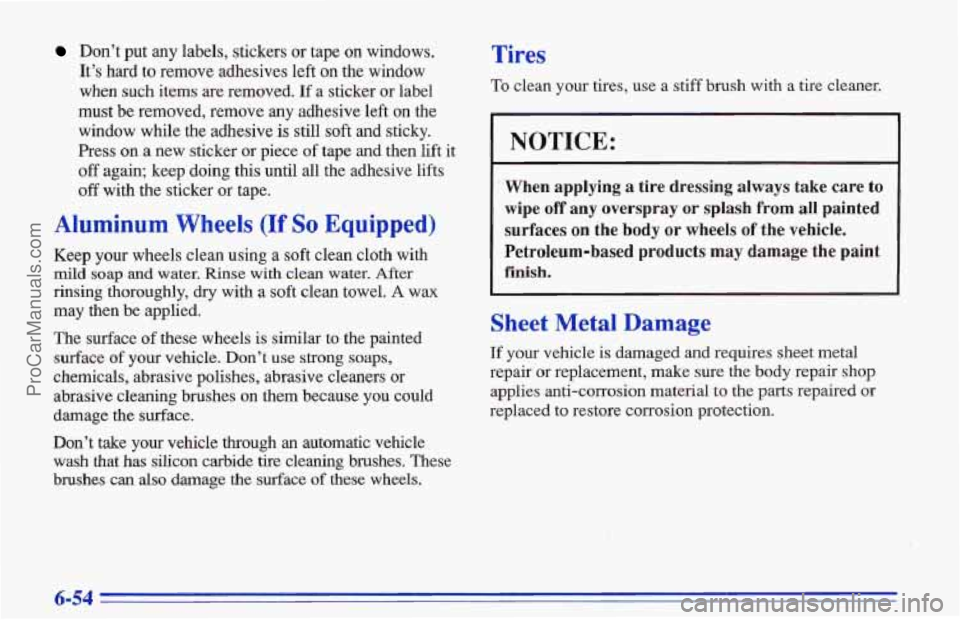
Don’t put any labels, stickers or tape on windows.
It’s
hard to remove adhesives left on the window
when such items are removed.
If a sticker or label
must
be removed, remove any adhesive left on the
window while the adhesive
is still soft and sticky.
Press on
a new sticker or piece of tape and then lift it
off again; keep doing this until all the adhesive lifts
off with the sticker or tape.
Aluminum Wheels (If So Equipped)
Keep your wheels clean using a soft clean cloth with
mild soap and water. Rinse with clean water. After
rinsing thoroughly, dry with a soft clean towel. A wax
may then be applied.
The surface
of these wheels is similar to the painted
surface
of your vehicle. Don’t use strong soaps,
chemicals, abrasive polishes, abrasive cleaners or
abrasive cleaning brushes on them because
you could
damage the surface.
Don’t take your vehicle through
an automatic vehicle
wash
that has silicon carbide tire cleaning brushes. These
brushes
can also damage the surface of these wheels.
Tires
To clean your tires, use a stiff brush with a tire cleaner.
I NOTICE:
’ When applying a tire dressing always take care to
wipe off any overspray or splash from all painted
surfaces on the body or wheels
of the vehicle.
Petroleum-based products may damage the paint
finish.
Sheet Metal Damage
If your vehicle is damaged and requires sheet metal
repair or replacement, make sure the body repair shop
applies anti-corrosion material to the
parts repaired or
replaced to restore corrosion protection.
6-54
ProCarManuals.com
Page 292 of 387
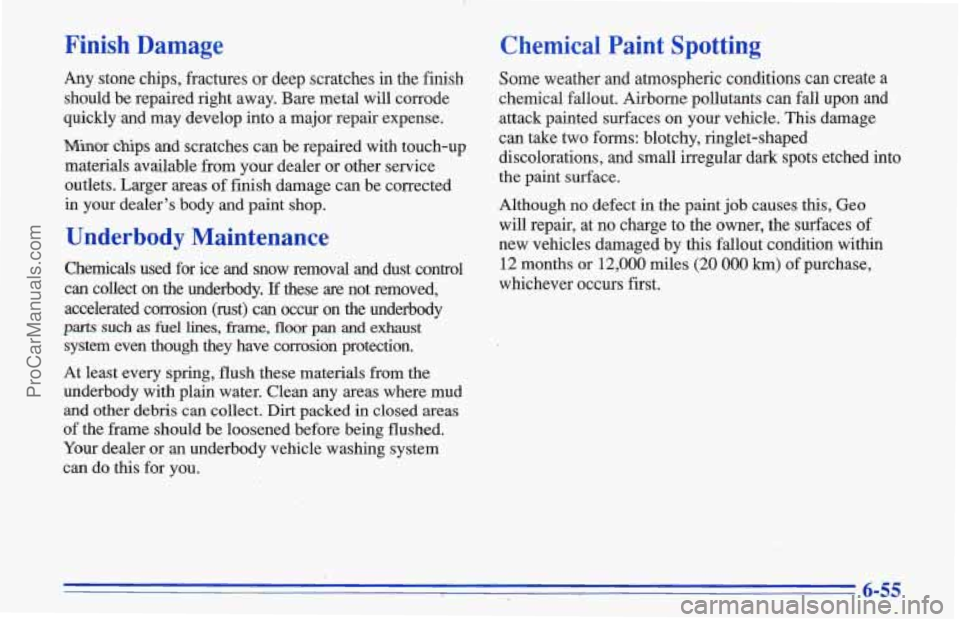
Finish Damage
Any stone chips, fractures or deep scratches in the finish
should be repaired right away. Bare metal
will corrode
quickly and may develop into a major repair expense.
'Miinor chips and scratches can be repaired with touch-up
materials available from your dealer or other service
outlets. Larger areas of finish damage can be corrected
in your dealer's body and paint shop.
Underbody Maintenance
Chemicals used for ice and snow removal and dust control
can collect on the underbody. If these are not removed,
accelerated corrosion (rust)
can occur on the underbody
parts such as fuel lines, frame, floor pan and exhaust
system even though they have corrosion protection.
At least every spring, flush these materials from the
underbody with plain water. Clean any areas where mud
and
other debris can collect. Dirt packed in closed areas
of the frame should be loosened before being flushed.
Your dealer or an underbody vehicle washing system
can do this for you.
Chemical Paint Spotting
Some weather and atmospheric conditions can create a
chemical fallout. Airborne pollutants can fall upon and
attack painted surfaces on your vehicle. This damage
can take two forms: blotchy, ringlet-shaped
discolorations, and small irregular dark spots etched into
the paint surface.
Although
no defect in the paint job causes this, Geo
will repair, at no charge to the owner, the surfaces of
new vehicles damaged by this fallout condition within
12 months or 12,000 miles (20 000 km) of purchase,
whichever occurs first.
6-55
ProCarManuals.com
Page 293 of 387
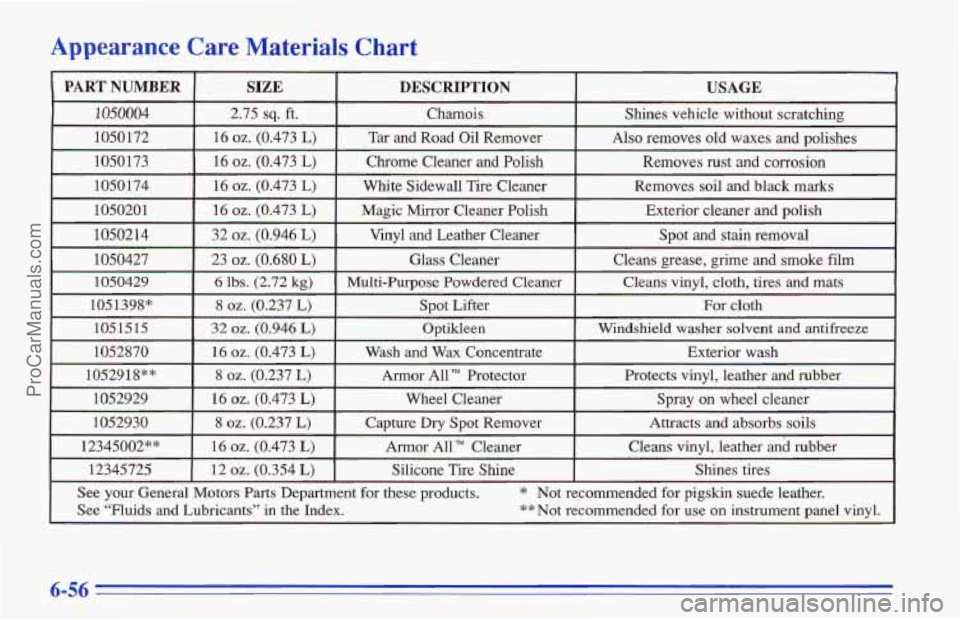
Appe,arance Care Materials Chart
6-56
ProCarManuals.com
Page 294 of 387
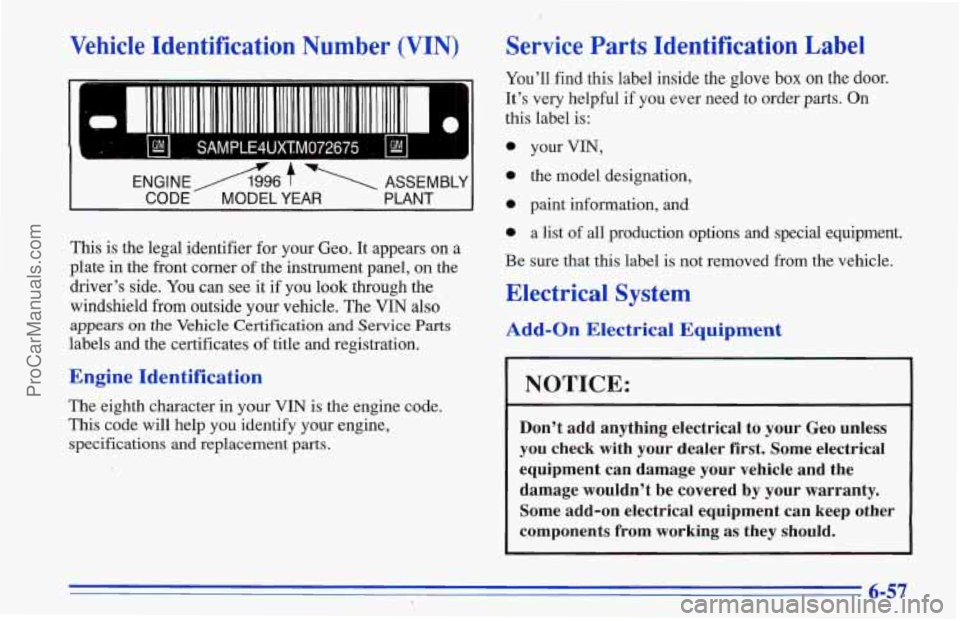
Vehicle Identification Number (VIN)
- - ..
c
I. ’ m. SAMPLE4UXTM072675 . 1
ENGINEAG $. ASSEMBLY
-
CODE MODEL YEAR PLANT
This is the legal identifier for your Geo. It appears on a
plate
in the front corner of the instrument panel, on the
driver’s side. You can see it
if you look through the
windshield
from outside your vehicle. The VIN also
appears
on the Vehicle Certification and Service Parts
labels and the certificates of title and registration.
Engine Identification
The eighth character in your VIN is the engine code.
This code will help
you identify your engine,
specifications and replacement parts.
Service Parts Identification Label
You’ll find this label inside the glove box on the door.
It’s very helpful if you ever need to order parts. On
this label is:
0
0
0
0
your VIN,
the model designation,
paint information, and
a list
of all production options and special equipment.
Be sure that this label is not removed from the vehicle.
Electrical System
Add-on Electrical Equipment
NOTICE:
Don’t add anything electrical to your Geo unless
you check with your dealer first. Some electrical
equipment can damage your vehicle and the
damage wouldn’t be covered by your warranty.
Some add-on electrical equipment can keep other
components from working
as they should.
6-57
ProCarManuals.com
Page 295 of 387
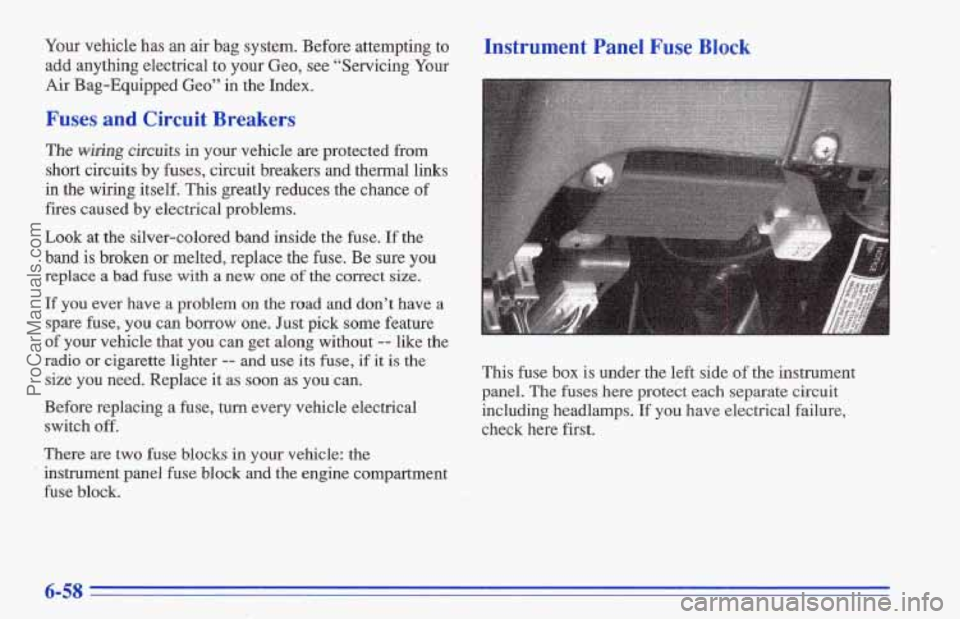
Your vehicle has an air bag system. Before attempting to
add anything electrical to your
Geo, see “Servicing Your
Air Bag-Equipped Geo” in the Index.
Fuses and Circuit Breakers
The wiring circuits in your vehicle are protected from
short circuits
by fuses, circuit breakers and thermal links
in the wiring itself. This greatly reduces the chance of
fires caused by electrical problems.
Look at the silver-colored band inside the fuse. If the
band is broken or melted, replace the fuse. Be sure you
replace a bad fuse with a new one of the correct size.
If you ever have a problem on the road and don’t have a
spare fuse,
you can borrow one. Just pick some feature
of your vehicle that you can get along without -- like the
radio or cigarette lighter
-- and use its fuse, if it is the
size you need. Replace it as soon as you can.
Before replacing
a fuse, turn every vehicle electrical
switch
off.
There are two fuse blocks in your vehicle: the
instrument panel fuse block and the engine compartment
fuse block.
Instrument Panel Fuse Block
This fuse box is under the left side of the instrument
panel.
The fuses here protect each separate circuit
including headlamps.
If you have electrical failure,
check here first.
ProCarManuals.com
Page 296 of 387
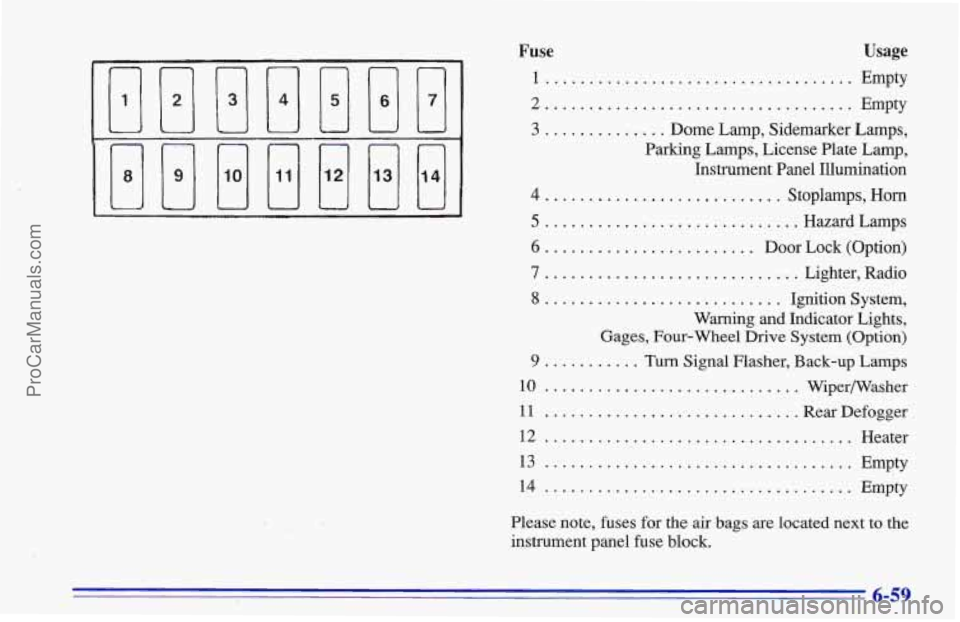
Fuse Usage
5
l... .............................. Empty
2................................... Empty
3 ............ Dome Lamp, Sidemarker Lamps,
Parking Lamps, License Plate Lamp, Instrument Panel Illumination
4 ........................... Stoplamps, Horn
5 ............................. Hazard Lamps
6..... ................. Door Lock (Option)
7 ............................. Lighter, Radio
8 ........................... Ignition System,
Warning and Indicator Lights,
Gages, Four-wheel Drive System (Option)
9 ........... Turn Signal Flasher, Back-up Lamps
10 .....
11 ...
...................... Wipermasher
.........
.. ..I .... Rear Defogger
12 ................................... Heater
13
................................. Empty
14 ................................... Empty
Please note, fuses for the air bags are located next to the
instrument
panel fuse block.
6-59
ProCarManuals.com
Page 297 of 387
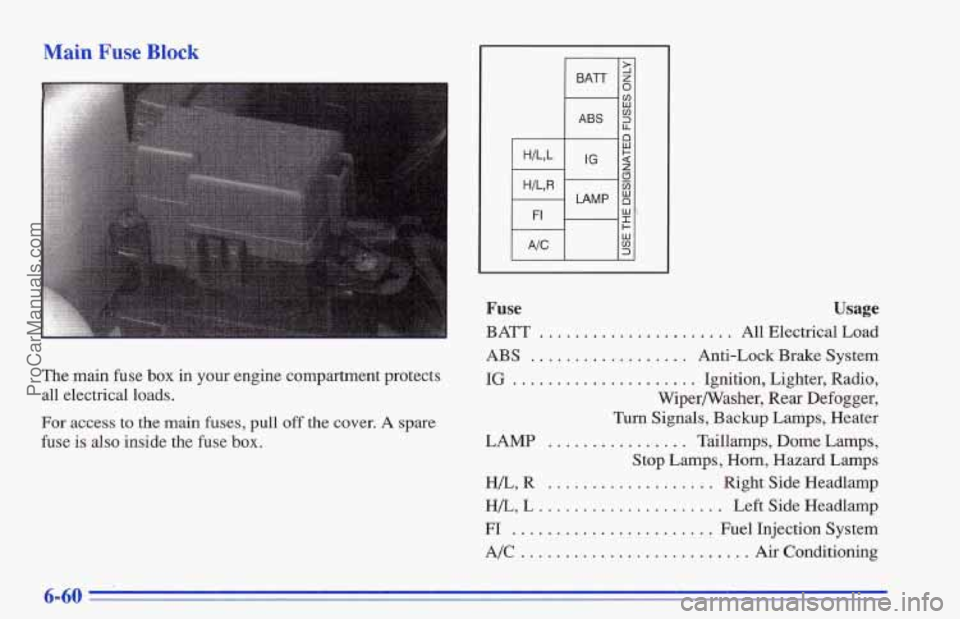
Main Fuse Block
The main fuse box in your engine compartment protects
all electrical loads.
For access
to the main fuses, pull off the cover. A spare
fuse is
also inside the fuse box.
Fuse
BATT ......
ABS .........
Usage
............ All Electrical Load
....... Anti-Lock Brake System
LAMP
...
IG . . ................. Ignition, Lighter, Radio,
Wiperwasher, Rear Defogger,
Turn Signals, Backup Lamps, Heater
Stop Lamps, Horn, Hazard Lamps
H/L, R ................... Right Side Headlamp
H/L, L ................. Left Side Headlamp
FI ....... .......... Fuel Injection System
A/C
.... ... ........ Air Conditioning
......... Taillamps, Dome Lamps,
6-60
ProCarManuals.com
Page 298 of 387
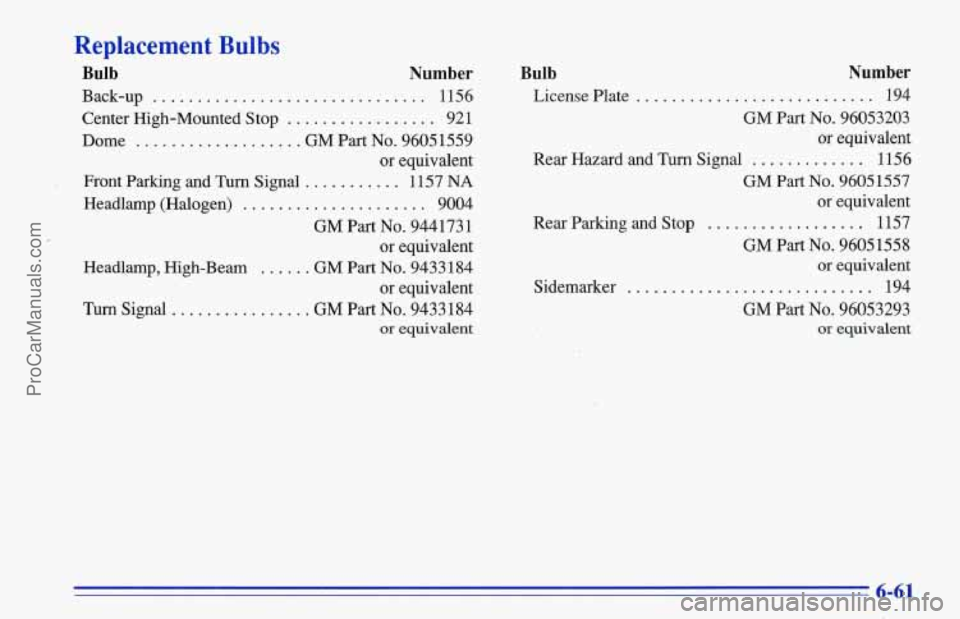
Replacement Bulbs
Bulb Number
Back-up ............................... 1156
Dome
................... GM Part No. 9605 1559
or equivalent
Front Parking and
Turn Signal ........... 1157 NA
Headlamp (Halogen) ..................... 9004
GM Part
No. 9441731
or equivalent
Headlamp, High-Beam
...... GM Part No. 9433184
or equivalent
Turn Signal ... . . GM Part No. 9433 184
or equivalent
Center High-Mounted Stop ................. 921
Bulb
License Plate . .
Number
................... 194
GM Part
No. 96053203
or equivalent
Rear Hazard and
Turn Signal ............. 1156
GM Part
No. 9605 1557
or equivalent
GM Part
No. 96051558
or equivalent
Sidemarker
............................ 194
GM Part
No. 96053293
or equivalent
Rear Parking and Stop .................. 1157
ProCarManuals.com
Page 299 of 387

Capacities and Specifications
Engine
Type ....................... . . L4
Compression Ratio ........ . . 9.5:l
Firing Order .......................... 1-3-4-2
Horsepower
.............................. 95
Fuel Delivery .................... Fuel Injection
Piston Displacement
............... 97 CID (I .6L)
Valve Arrangement ............ ~n-~ead T? Type
AC Belt Tension ....... Deflect Belt 0.24-0.3 inch
(6-9 mm) @ 22 lbs. (10 kg) Pressure
Fan Belt Tension
Inspection
........... Deflect Belt 0.24-0.32 inch
Replacement
.......... Deflect Belt 0.20-0.28 inch
(4-8 mm)'@ 22 lbs. (10 kg) Pressure
(5-7 mm) @ 22 lbs. (10 kg) Pressure
Specification
........... , . 180°F (82°C)
Thermostat Temperature,
Replacement Parts
Air Cleaner Filter ................. 13780-58B20
GM Part No. 96068629 or equivalent
Engine Oil Filter
.......... GM Part No. 25014441
GM Part No. 96058022 or equivalent
PCV Valve .... GM Part No. 96058079 or equivalent
Radiator Pressure Cap
............ 13 psi (90 kPa)
0.028-0.032 inch gap
(0.7 to 9.8 mm)
Battery ............................. 26R-50s
Fuel Filter
..................... AC Type GF571
Spark Plug ................... AC Type R43XLS
ProCarManuals.com
Page 300 of 387
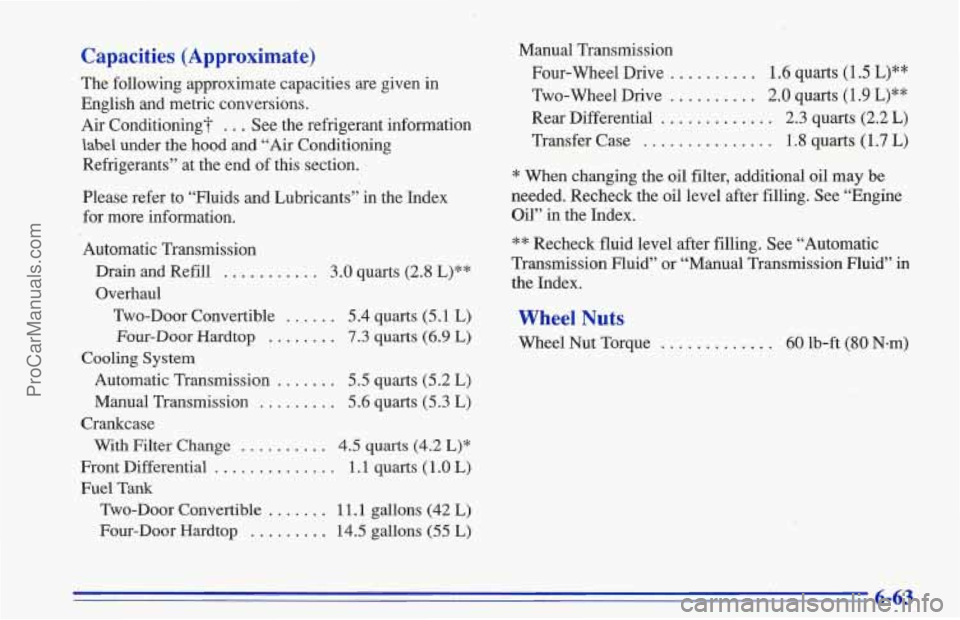
Capacities (Approximate)
The following approximate capacities are given in
English and metric conversions.
label under the hood and “Air Conditioning
Refrigerants” at the end of this section.
Air Conditioning?
... See the refrigerant information
Please refer to “Fluids and Lubricants” in the Index
for more information.
Automatic Transmission Drain and Refill
...... . 3.0 quarts (2.8 L)**
Overhaul
Two-Door Convertible
...... 5.4 quarts (5.1 L)
Four-Door Hardtop
........ 7.3 quarts (6.9 L)
Automatic Transmission ....... 5.5 quarts (5.2 L)
Manual Transmission
....... 5.6 quarts (5.3 L)
With Filter Change ........ 4.5 quarts (4.2 L)*
Front Differential ............ 1.1 quarts (1.0 L)
Fuel Tank
Two-Door Convertible
....... 11.1 gallons (42 L)
Four-Door Hardtop ......... 14.5 gallons (55 L)
Cooling System
Crankcase Manual Transmission
Four-wheel Drive
........ 1.6 quarts (1.5 L)**
Two-Wheel Drive .......... 2.0 quarts (1.9 L)**
Rear Differential ............. 2.3 quarts (2.2 L)
Transfer Case ............... 1.8 quarts (1.7 L)
* When changing the oil filter, additional oil may be
needed. Recheck the oil level after filling. See “Engine
Oil” in the Index.
** Recheck fluid level after filling. See “Automatic
Transmission Fluid” or “Manual Transmission Fluid” in
the Index.
Wheel Nuts
Wheel Nut Torque ............. 60 lb-ft (80 N-m)
6-63
ProCarManuals.com